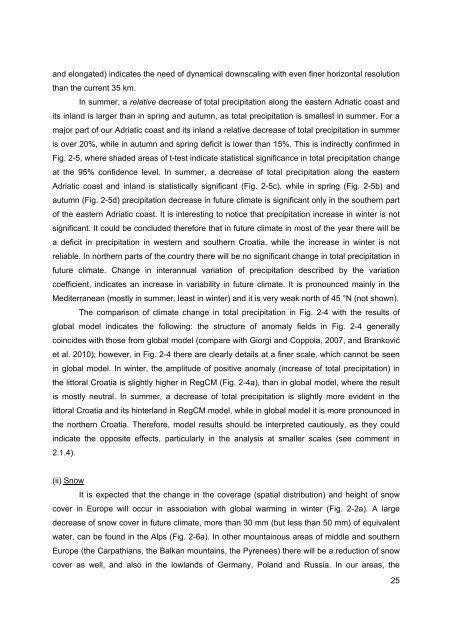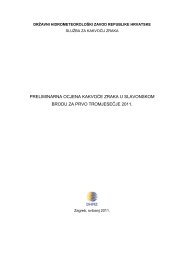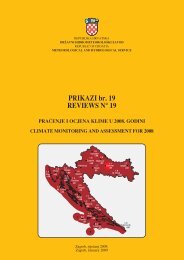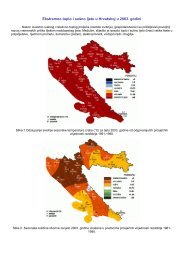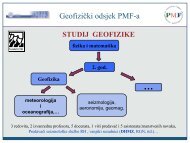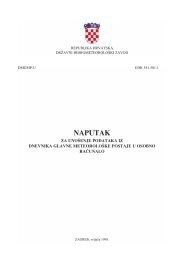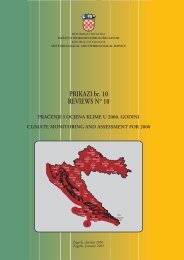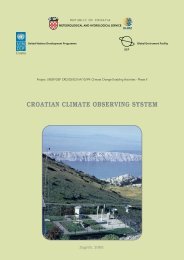Observed climate changes in Croatia Climate change scenario
Observed climate changes in Croatia Climate change scenario
Observed climate changes in Croatia Climate change scenario
You also want an ePaper? Increase the reach of your titles
YUMPU automatically turns print PDFs into web optimized ePapers that Google loves.
and elongated) <strong>in</strong>dicates the need of dynamical downscal<strong>in</strong>g with even f<strong>in</strong>er horizontal resolution<br />
than the current 35 km.<br />
In summer, a relative decrease of total precipitation along the eastern Adriatic coast and<br />
its <strong>in</strong>land is larger than <strong>in</strong> spr<strong>in</strong>g and autumn, as total precipitation is smallest <strong>in</strong> summer. For a<br />
major part of our Adriatic coast and its <strong>in</strong>land a relative decrease of total precipitation <strong>in</strong> summer<br />
is over 20%, while <strong>in</strong> autumn and spr<strong>in</strong>g deficit is lower than 15%. This is <strong>in</strong>directly confirmed <strong>in</strong><br />
Fig. 2-5, where shaded areas of t-test <strong>in</strong>dicate statistical significance <strong>in</strong> total precipitation <strong>change</strong><br />
at the 95% confidence level. In summer, a decrease of total precipitation along the eastern<br />
Adriatic coast and <strong>in</strong>land is statistically significant (Fig. 2-5c), while <strong>in</strong> spr<strong>in</strong>g (Fig. 2-5b) and<br />
autumn (Fig. 2-5d) precipitation decrease <strong>in</strong> future <strong>climate</strong> is significant only <strong>in</strong> the southern part<br />
of the eastern Adriatic coast. It is <strong>in</strong>terest<strong>in</strong>g to notice that precipitation <strong>in</strong>crease <strong>in</strong> w<strong>in</strong>ter is not<br />
significant. It could be concluded therefore that <strong>in</strong> future <strong>climate</strong> <strong>in</strong> most of the year there will be<br />
a deficit <strong>in</strong> precipitation <strong>in</strong> western and southern <strong>Croatia</strong>, while the <strong>in</strong>crease <strong>in</strong> w<strong>in</strong>ter is not<br />
reliable. In northern parts of the country there will be no significant <strong>change</strong> <strong>in</strong> total precipitation <strong>in</strong><br />
future <strong>climate</strong>. Change <strong>in</strong> <strong>in</strong>terannual variation of precipitation described by the variation<br />
coefficient, <strong>in</strong>dicates an <strong>in</strong>crease <strong>in</strong> variability <strong>in</strong> future <strong>climate</strong>. It is pronounced ma<strong>in</strong>ly <strong>in</strong> the<br />
Mediterranean (mostly <strong>in</strong> summer, least <strong>in</strong> w<strong>in</strong>ter) and it is very weak north of 45 °N (not shown).<br />
The comparison of <strong>climate</strong> <strong>change</strong> <strong>in</strong> total precipitation <strong>in</strong> Fig. 2-4 with the results of<br />
global model <strong>in</strong>dicates the follow<strong>in</strong>g: the structure of anomaly fields <strong>in</strong> Fig. 2-4 generally<br />
co<strong>in</strong>cides with those from global model (compare with Giorgi and Coppola, 2007, and Branković<br />
et al. 2010); however, <strong>in</strong> Fig. 2-4 there are clearly details at a f<strong>in</strong>er scale, which cannot be seen<br />
<strong>in</strong> global model. In w<strong>in</strong>ter, the amplitude of positive anomaly (<strong>in</strong>crease of total precipitation) <strong>in</strong><br />
the littoral <strong>Croatia</strong> is slightly higher <strong>in</strong> RegCM (Fig. 2-4a), than <strong>in</strong> global model, where the result<br />
is mostly neutral. In summer, a decrease of total precipitation is slightly more evident <strong>in</strong> the<br />
littoral <strong>Croatia</strong> and its h<strong>in</strong>terland <strong>in</strong> RegCM model, while <strong>in</strong> global model it is more pronounced <strong>in</strong><br />
the northern <strong>Croatia</strong>. Therefore, model results should be <strong>in</strong>terpreted cautiously, as they could<br />
<strong>in</strong>dicate the opposite effects, particularly <strong>in</strong> the analysis at smaller scales (see comment <strong>in</strong><br />
2.1.4).<br />
(ii) Snow<br />
It is expected that the <strong>change</strong> <strong>in</strong> the coverage (spatial distribution) and height of snow<br />
cover <strong>in</strong> Europe will occur <strong>in</strong> association with global warm<strong>in</strong>g <strong>in</strong> w<strong>in</strong>ter (Fig. 2-2a). A large<br />
decrease of snow cover <strong>in</strong> future <strong>climate</strong>, more than 30 mm (but less than 50 mm) of equivalent<br />
water, can be found <strong>in</strong> the Alps (Fig. 2-6a). In other mounta<strong>in</strong>ous areas of middle and southern<br />
Europe (the Carpathians, the Balkan mounta<strong>in</strong>s, the Pyrenees) there will be a reduction of snow<br />
cover as well, and also <strong>in</strong> the lowlands of Germany, Poland and Russia. In our areas, the<br />
25


